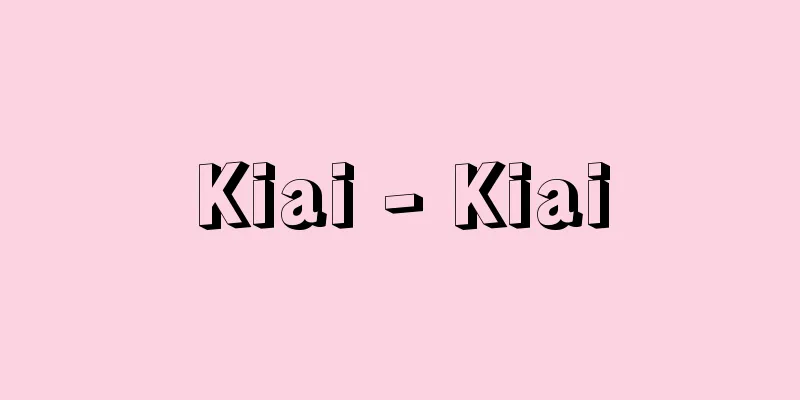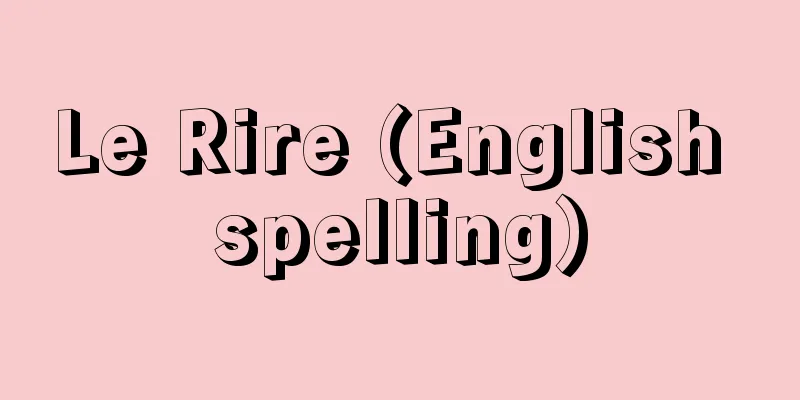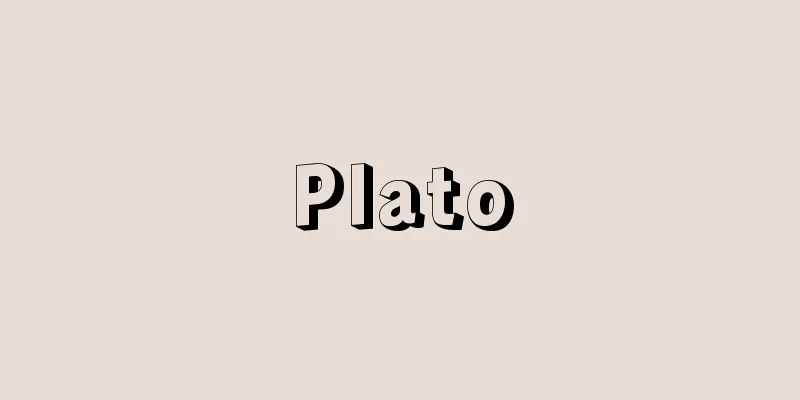Insurance - hoken (English spelling) insurance

|
In today's society, where technology has become highly advanced and complex, various risks (dangers) exist and we live in this environment. Insurance, an economic system, is one part of risk management. Risk management is a management technique for effectively dealing with risks. The method consists of (1) identifying risks, (2) analyzing risks, (3) selecting risk control methods, and (4) implementing risk control methods and evaluating their results. The first risk control method in (3) above is risk control, which means preventing and reducing accidents. The second is risk financing, which means a cash flow plan after an accident has occurred. Risk financing is divided into (1) savings/self-insurance, which does not transfer risks to others, and (2) insurance, which transfers risks to others. [Takuji Kaneko and Mitsuo Sakaguchi] The Establishment of Modern InsuranceLooking at the history of insurance, there are two trends. One is a system of mutual relief seen in ancient Collegia Tenuiorum and medieval guilds, and the other is a contract that aims to shift accidental losses to others through transactions, which was widely used in ancient times as sea leases and in medieval Italy as adventure leases. Since both parties were early capitalists and engaged in commercial transactions, it would be reasonable to trace the lineage of modern insurance to sea leases and adventure leases. However, even if it is permissible to understand insurance as a transaction, there are problems. This is because, when viewed as an individual transaction, insurance has a different nature from other transactions such as buying and selling, lending and borrowing. Even when viewed as individual transactions, buying and selling and lending transactions are rational transactions, although there are differences in the interests of the parties involved. However, in the case of insurance, when viewed as an individual transaction, the occurrence of the accident that is the subject of the transaction is determined by chance, so the actions of the parties in the transaction involve an element of gambling and speculation. For this reason, in order for insurance underwriting to be established as a profitable business, the subjective condition is the elimination of this gambling element, that is, the establishment of a rational rate system, and this condition is met by the objective condition of the increase in insured properties due to the emergence of a modern capitalist economy. The process by which such special insurance transactions were established as modern insurance first developed around the compensation for accidental losses in the most important aspect of capital movement, which is the center of social reproduction in capitalist society, and insurance by profit-making companies was first established as corporate insurance (historically, marine insurance in the 14th century and fire insurance in the 17th century). The insurance industry (insurance capital) is not something that must only cover accidental damages of capital. In other words, as long as there is uncertainty about household finances run by capital, the essential basis of insurance remains the same, and insurance capital can newly carry out risk-bearing activities in this area, and in the 18th century, the life insurance industry, which is household insurance, was established. The new types of insurance that appeared later can be seen as the development and growth of insurance capital in response to the development of capitalism, seeking new areas of profit-making. In addition, in social insurance, which began at the end of the 19th century, the insurer is not individual capital that is based on the principle of profit-seeking, but rather what could be called total social capital (the state, local government, etc.), and so its nature is different; however, social insurance targets the financial insecurity of working-class people created by capital, and therefore the essential basis of insurance is the same, so insurance techniques adopted in already established modern insurance systems are used for social insurance. Although Japan has had something similar to insurance since ancient times, the modern insurance system was introduced from Europe and the United States after the Meiji Restoration. Fukuzawa Yukichi was the first to introduce the Western insurance system to Japan, and in his Western Travel Guide published in 1867 (Keio 3), he explained three types of disaster insurance: "Insurance for a person's life," "Fire insurance," and "Marine insurance." After several trials, the insurance business itself began in earnest with the establishment of Tokio Marine Insurance Company in 1879 (Meiji 12) (the predecessor of Tokio Marine & Nichido Fire Insurance Co., Ltd., which became Tokio Marine & Nichido Fire Insurance Co., Ltd. in 2004), Meiji Life Insurance Company in 1881 (the predecessor of Meiji Life Insurance Mutual Company, which became Meiji Yasuda Life Insurance Co., Ltd. in 2004), and Tokyo Fire Insurance Company in 1887 (later Yasuda Fire and Marine Insurance Co., Ltd., which became Sompo Japan Insurance Inc. in 2002 and then merged with Nipponkoa Insurance to become Sompo Japan Nipponkoa Insurance Inc. in 2014). [Takuji Kaneko and Mitsuo Sakaguchi] Insurance classificationInsurance can be classified according to different criteria as follows: (1) Public Insurance and Private Insurance Public insurance refers to insurance operated by the state or other public organizations as a means of implementing public policies, and is divided into social insurance as a means of implementing social policies and industrial insurance as a means of implementing economic policies. Health insurance, employment insurance (unemployment insurance), employees' pension insurance, and workers' accident compensation insurance fall into the former category, while forest fire insurance (forest insurance), small and medium-sized enterprise credit insurance, and trade insurance fall into the latter category. In these public insurance systems, the state or other public organizations often act as the insurer and directly underwrite the insurance, but there are also cases where a special public corporation or private insurance association formed by those who benefit from the insurance is allowed to underwrite the direct insurance, and the state undertakes the reinsurance. In contrast, private insurance refers to insurance operated purely from the private economic standpoint of the parties involved, and there is no plan for financial assistance or subsidies from the state or other public organizations, and there is no so-called compulsory enrollment. (2) Property Insurance or Property Insurance and Personal Insurance Classification based on the object of the insured accident. Property insurance refers to insurance in which the insured accident occurs to the policyholder's property, and many insurance policies in which the insured accident occurs to specific objects are called property insurance. Property insurance is divided into many types depending on the object and type of the insured accident, but the main types include hull insurance, cargo insurance, fire insurance, transportation insurance, theft insurance, aviation insurance, automobile insurance, liability insurance, comprehensive movable property insurance, credit insurance, and surety insurance. Personal insurance is insurance in which the insured accident occurs to the human body, and includes life insurance, disease insurance, and accident insurance. (3) Property (unfixed amount) insurance and fixed amount insurance: Standards for determining the amount of insurance payable when an insured event occurs. Property insurance or property insurance is, in principle, property insurance. Personal insurance, on the other hand, is generally fixed amount insurance, but there are also cases of unfixed amount insurance, such as accident insurance. (4) Property Insurance and Life Insurance In Japan's Insurance Act and Insurance Business Act, there are provisions dividing insurance into property insurance and life insurance. In practice, it is common to divide insurance into these two areas. However, this classification is not correct in theory. This is because property insurance is classified based on the method of determining the amount of insurance money that the insurer must pay, while life insurance is classified based on the subject or type of insured accident. However, in practice, this is not particularly inconvenient. (5) Commercial Insurance and Household Insurance Commercial insurance is insurance used primarily by companies to deal with uncertainties in the company's economy, and the insurance premiums are paid from the company's accounting department. This includes marine insurance and fire insurance for company buildings and machinery. Household insurance is insurance used by household finance officers to deal with uncertainties in the household economy, and the insurance premiums are paid from individual household funds. Ordinary life insurance and fire insurance for the average household's home and household goods belong to this category. In economic theory, this is the most correct classification. [Takuji Kaneko and Mitsuo Sakaguchi] Insurance FunctionsThe purpose of insurance is to eliminate the economic anxiety caused by random accidents, but the way in which it functions differs between corporate insurance and household insurance. First, let us look at the special functions of corporate insurance (insurance capital), which was established with a rational rate system as the subjective condition and the emergence of a capitalist economy as the objective condition. Needless to say, insurance is not production, and insurance capital is not productive capital. In a capitalist society, in order for a capital form that is not productive capital (industrial capital) to exist as special capital and become independent, a part of the function of industrial capital must become independent as a special function in the first place. Meanwhile, capital must protect itself from accidental accidents and disasters, but in order to proceed with the reproduction process without anxiety, it is necessary to prepare a considerable amount of money in preparation for these accidental accidents and disasters. This money is a special monetary reserve that should be held additionally without being directly related to the production and circulation of capital. Capital strives to keep this monetary reserve more rationally and to a small amount. This is where insurance handling labor comes in. Insurance capital is what takes over from this insurance handling labor and makes it independent. Insurance capital specializes in insurance handling work, and thereby fulfills the social function of saving on the additional monetary reserves mentioned above and the costs associated with insurance handling work (which together become insurance premiums). In contrast, life insurance capital (life insurance capital), which is independent as household insurance, also performs insurance business as its original function, but unlike corporate insurance, this function is not carried out as a differentiated and independent function of industrial capital. Therefore, life insurance capital has no relationship with industrial capital in its original insurance business. For this reason, while in the case of corporate insurance, capital willingly enters into insurance contracts, in the case of life insurance, the premiums paid by the policyholder are the source of household income, and since there is a general tendency in consumer life to prefer present goods over future goods, it must actively work with households to acquire policyholders. Furthermore, insurance not only provides protection to the insured and eliminates economic anxiety, but also gives others a sense of security and increases social credibility. Without insurance contracts such as marine insurance for trade and fire insurance for collateral property, transactions and lending and borrowing would not be carried out smoothly. The above are the original characteristics and functions of insurance, but as the business and volume of transactions increase, the risk of liability is leveled out and the need for insurance payments is offset and reduced, resulting in the accumulation and precipitation of money in the hands of insurance capital, which is then used and invested in new areas of profit as monetary capital. This is where the financial institution function of insurance, which has expanded into other fields, is born. [Takuji Kaneko and Mitsuo Sakaguchi] Insurance ManagementGiven the unique characteristics of insurance transactions, the following can be considered as general principles for insurance management: (1) Principle of large risk Acquiring a large number of contracts not only increases the income of insurance companies, but also leads to the averaging of risk through the law of large numbers. (2) Principle of homogeneity of risk In order for insurance management to be carried out rationally, it is not enough to simply collect a large number of contracts; those contracts must be homogeneous in terms of the degree of risk. This is necessary in order to average out risk through the action of the law of large numbers. Therefore, classification and selection of risks are necessary. (3) Principle of Appropriateness of Premiums Calculating appropriate premiums for the subjects of insurance that have different types and degrees of risk and applying these to each individual case is an important issue in insurance management. Premiums must be reasonable and fair. (4) Principle of risk diversification In order to average out risk, contracts must be collected over as wide an area as possible. If the insured are concentrated in a specific area, the occurrence of a single accident can cause enormous damage. In addition, reinsurance and coinsurance are important methods of risk diversification, and both are means of averaging out risk by dividing it up. (5) Principle of fairness in insurance benefits This principle is the flip side of the principle of fairness in insurance premiums. Even if insurance premiums are fair, rational insurance management cannot be carried out if insurance benefits are not fair. Fair insurance benefits are relatively easy for fixed-price insurance such as life insurance, but are a difficult issue for non-life insurance. (6) Principle of investment certainty In insurance management, the quality of so-called financial institution operations, that is, the lending and investment operations of insurance funds accumulated through insurance premiums, has a significant bearing on the performance of the insurance management. In addition, since insurance companies deal with a large number of policyholders and payments depend on the future, it is common for there to be some state supervision from the perspective of the public interest. [Takuji Kaneko and Mitsuo Sakaguchi] "Kimura Eiichi and Niwata Noriaki (eds.), Introduction to Insurance (1976/New edition, 1984, Yuhikaku)" ▽ "Iguchi Tomio, The Industrial Structure of the Modern Insurance Industry: Deregulation and New Competition (1996, NTT Publishing)" ▽ "Suzuki Tatsunori (ed.), Imaizumi Takatada et al., New Insurance Theory: Life and Insurance (2003, Seibundou)" ▽ "Yoshizawa Takuya, How Insurance Works: Understanding Insurance Functionally (2006, Chikura Shobo)" ▽ "Tamura Yuichiro, Takao Atsushi and Okada Taishi (eds.), New Trends in the Insurance System (2008, Chikura Shobo)" ▽ "Kimura Eiichi et al., Knowledge of Insurance (Yuhikaku Shinsho)" ▽ "Fukuda Hisao, Common Sense About Insurance (Nikkei Bunko)" [Reference items] | | | | | | | | | | | | | | | | Fire Insurance| insurance| | | | | | | | | | | | [Supplementary materials] |Mitsubishi No. 2 Building, where the company's headquarters were located. Yaesu-cho, Kojimachi Ward (currently Marunouchi, Chiyoda Ward, Tokyo). "Famous Places in Japan" (1900, Meiji 33), National Diet Library . Meiji Life Insurance (Meiji period) The company's headquarters was located in Nishikawashi-cho, Nihonbashi-ku (currently Yaesu, Chuo-ku, Tokyo). "Famous Places in Japan" (1900, Meiji 33) National Diet Library Tokyo Fire Insurance Source: Shogakukan Encyclopedia Nipponica About Encyclopedia Nipponica Information | Legend |
|
技術が高度に発展し複雑化している現在の社会にはさまざまなリスク(危険)が存在し、そのなかで私たちは生活している。保険という経済制度はリスク・マネジメントの一部を占めている。リスク・マネジメントとは、リスクを効果的に処理するための経営管理上の一手法をいう。その方法は、(1)リスクの確認、(2)リスクの分析、(3)リスク制御方法の選択、(4)リスク制御方法の実行とその結果に対する評価、からなっている。そして、前記(3)のリスク制御方法として第一にリスク・コントロールがあるが、これは事故の予防と軽減を意味する。第二はリスク・ファイナンシングであり、これは事故が発生した後の資金繰り計画を意味する。リスク・ファイナンシングは(1)リスクを他人に転嫁しない貯蓄・自家保険と、(2)リスクを他人に転嫁する保険に区別される。 [金子卓治・坂口光男] 近代的保険の成立保険史をみると、保険には二つの流れがある。一つは古代のコレギア・テヌイオルム、中世のギルドなどにみられた相互救済の制度であり、もう一つは、取引によって偶然的損害を他に転嫁しようとするもので、古代においては海上貸借として、中世のイタリアにおいては冒険貸借として広く行われた契約である。当事者のいずれもが前期的資本であり、営利的取引であったという点から、近代的保険の系譜を海上貸借、冒険貸借に求めるのが順当であろう。 しかし、保険を取引として把握することが許されるとしても問題はある。というのは、保険を個々の取引としてみた場合、他の売買、貸借などの取引と異なった性格をもっているからである。売買取引、貸借取引は、それを個々の取引としてみても、当事者に利害の相違はあるが合理的な取引である。ところが、保険の場合、それを個々の取引でみると、その取引の対象となる事故の発生は偶然によって左右されるから、取引の当事者の行為には賭博(とばく)性、射倖(しゃこう)性を伴っている。このため保険引受けが営利的な企業として成立するためには、この賭博性の排除、つまり合理的料率制度の成立ということが主体的条件となり、この条件は、近代的な資本主義経済の登場による付保物件の増大という客観的条件によって満たされる。 このような特殊な保険取引が近代的保険として成立する過程は、まず、資本主義社会における社会的再生産の中心としてもっとも重要な資本の運動部面における偶然的損害の填補(てんぽ)ということを中心に展開され、営利的企業による保険はまず企業保険(歴史的には14世紀に海上保険、17世紀に火災保険)として確立された。保険業(保険資本)は、単に資本の偶然的災害だけを対象としなければならない性質のものではない。すなわち、資本のもとで営まれる家計の不安が存在する限り、保険としての本質的基盤は同一であり、それを対象として、保険資本がこの部面での危険負担活動を新たに行うことが可能となり、18世紀には家計保険である生命保険業も成立したのである。その後登場してきた新種保険は、保険資本が、資本主義の発展に対応して、新たな利殖部面を求めて展開、発展した姿としてとらえることができる。 なお、19世紀末に始まった社会保険においては、保険者は営利追求を原則とする個別的資本ではなく、いわば社会的総資本(国家、自治体など)であり、その性格を異にするが、社会保険が対象とするのは、資本によって生み出された労働者階級の家計の不安であり、したがって保険としての本質的基盤は同一であるから、すでに確立された近代的保険制度において採用されている保険技術が、社会保険のために利用されることになる。 日本にも古くから保険に類似したものはあったが、近代的な保険制度は、明治維新後に欧米から導入されたものである。欧米の保険制度を日本に初めて紹介したのは福沢諭吉(ふくざわゆきち)で、1867年(慶応3)刊行の『西洋旅案内』のなかで、「災難請合の事 イシュアランス」と題し、「人の生涯を請合ふ事」「火災請合」「海上請合」の3通りの災難請合について解説している。保険事業そのものは、いくつかの試行を経たのち、本格的には、1879年(明治12)の東京海上保険会社(東京海上火災保険株式会社の前身。2004年に東京海上日動火災保険株式会社となる)、1881年の明治生命保険会社(明治生命保険相互会社の前身。2004年に明治安田生命保険相互会社となる)、1887年の東京火災保険会社(のちの安田火災海上保険株式会社。2002年に株式会社損害保険ジャパンとなり、さらに日本興亜損害保険と経営統合し、2014年、損害保険ジャパン日本興亜となる)の設立によって始まった。 [金子卓治・坂口光男] 保険の分類保険は、いろいろな標準に従って次のように分類することができる。 (1)公保険と私保険 公保険とは、国家その他の公共団体が公的な政策の実現手段として運営する保険をいい、社会政策実現手段としての社会保険、経済政策実現手段としての産業保険などに分けられる。健康保険、雇用保険(失業保険)、厚生年金保険、労働者災害補償保険などは前者に、森林火災保険(森林保険)、中小企業信用保険、貿易保険などは後者にあたる。これらの公保険制度にあっては、国家その他の公共団体が自ら保険者となって、直接的に保険を引き受けることが多いが、保険の利益を受ける者によって結成された特殊の公法人または私法人たる保険組合をして元受保険を引き受けさせ、国家がその再保険を引き受ける方式によることもある。これに対し私保険は、関係者の純然たる私経済的見地から運営される保険をいい、国家その他の公共団体からの財政的補助・助成は予定されず、いわゆる加入強制はない。 (2)物(ぶつ)保険ないし財産保険と人(じん)保険 保険事故発生の客体を標準とした分類。財産保険とは、加入者の財貨について生じる事故を保険事故とするものをいい、とくに具体的な物について生ずる事故を保険事故とするものが多く、これを物保険という。財産保険は、その保険事故の客体や種類のいかんにより多くの種類に分けられるが、おもなものには船舶保険、積荷保険、火災保険、運送保険、盗難保険、航空保険、自動車保険、賠償責任保険、動産総合保険、信用保険、保証保険などがある。人保険は、人体について生じる事故を保険事故とする保険であり、生命保険、疾病保険、傷害保険などがある。 (3)損害(不定額)保険と定額保険 保険事故発生に際して支払われる保険金の額の定め方いかんを標準としたもの。財産保険または物保険は原則として損害保険である。これに対し人保険は定額保険が原則であるが、傷害保険などで不定額保険の場合もある。 (4)損害保険と生命保険 日本の保険法や保険業法では、保険を損害保険と生命保険に分けて規定を設けている。実務上も保険をこの両分野に分けるのが普通である。しかし、この分類は理論的には正しくない。損害保険は保険者の支払うべき保険金の額の決定方法を分類の標準とするが、生命保険は保険事故の対象ないし種類を標準とするからである。ただし、実際上はさほど不都合とはいえない。 (5)企業保険と家計保険 企業保険は主として企業が企業経済の不安に対処するために利用する保険をいい、その保険料は企業の経理から支払われるもので、海上保険、企業用の建物や機械の火災保険などはこれに属する。家計保険は家計の不安に対処するために家計担当者が利用する保険であり、保険料は個人の家計のなかから支払われる。普通の生命保険、一般家庭の住宅や家財道具の火災保険などはこれに属する。経済理論上はもっとも正しい分類である。 [金子卓治・坂口光男] 保険の機能保険は、偶然に発生する事故によって生ずる経済的不安を除くことを目的とするが、その機能の形成は企業保険と家計保険とでは異なっている。 まず、合理的料率制度を主体的条件とし、資本主義経済の登場を客観的条件として成立した企業保険(保険資本)の特別の機能をみる。いうまでもなく保険は生産ではなく、保険資本も生産資本ではない。資本主義社会において、生産資本(産業資本)でない資本形態が特殊資本として実在し、自立化しうるためには、第一次的には産業資本の機能の一部が、特殊機能として自立化しなければならない。ところで、資本は偶然的な事故・災害から自己を守らなければならないが、再生産過程を不安なく進行させるためには、この偶然的な事故・災害に備えて相当額の貨幣を用意しておく必要がある。この貨幣は資本の生産・流通に直接関係なく追加的にもつべき特殊な貨幣準備金である。そして資本はこの貨幣準備金をより合理的にしかも少額にとどめようと努める。そこから保険取扱労働が登場する。この保険取扱労働を代行して自立化したのが保険資本である。保険資本は保険取扱労働を専業的に担当するが、そのことによって、先の追加的貨幣準備金と、保険取扱労働に伴う費用(あわせて保険料となる)を節約するという社会的機能を果たすことになる。 これに対してもっぱら家計保険として自立化している生命保険資本(生保資本)も、本来の機能として保険取扱業務を行うが、この機能は企業保険の場合と異なって、産業資本の機能が分化、自立化したものとして遂行されるのではない。したがって生保資本は、その本来の保険業務において産業資本との関係をもたない。このため、企業保険の場合は資本が自ら進んで保険契約を取り結ぶのに対し、生命保険においては、その加入者の支払う保険料が家計所得を源泉とし、一般に消費生活においては将来財より現在財が選好される傾向があるため、加入者獲得のために、家計に対して積極的に働きかけなければならない。 なお、保険はひとり加入者に対して保障を約し、経済不安を除くだけではなく、そのことによって他人にも安心感を与え、社会的信用を高からしめる。貿易における海上保険、担保物件に対する火災保険など、もしこれらの保険契約がなければ、取引も貸借も円滑には行われないであろう。 以上は保険の本来の性格と機能であるが、その営業、取引量の増大に伴って、負担危険が平準化され、保険金支払いの必要度は相殺されて減少し、その結果保険資本の手元に貨幣が累積沈殿することになり、この沈殿した貨幣が、貨幣資本として新たな利殖部面を求めて他用され投資される。ここに他の分野に進入した保険の金融機関的機能が生まれてくる。 [金子卓治・坂口光男] 保険の経営保険取引の特異性ということもあって、保険経営の原則として大要次のものが考えられる。 (1)危険大量の原則 多数の契約を獲得することは、単に保険経営の収入を増すだけでなく、大数法則の作用により危険の平均化がみられるようになる。 (2)危険同質性の原則 保険経営が合理的に行われるためには、単に多数の契約を集めるだけでなく、それらの契約が危険の程度について同質的でなければならない。これは大数法則の作用により危険の平均化を図るために必要である。そこで、危険の分類と選択が必要となる。 (3)保険料適正の原則 危険の種類および程度を異にする保険の対象に対して、それぞれ適正な保険料を算出し、これを個々の場合に適用することは保険経営上重要な事柄である。保険料は相当かつ公正でなければならない。 (4)危険分散の原則 危険の平均化を図るためには、できるだけ広い範囲にわたって契約を集めなければならない。保険対象が特定の地域に集中するときは、1回の事故の発生により多大の損害を生じるからである。また、危険分散の方法として重要なのは再保険と共同保険であり、両者は危険の分割によって危険の平均化を図る手段となる。 (5)保険給付適正の原則 これは保険料適正の原則と表裏の関係にある原則であり、保険料が適正であっても、保険給付が適正でなければ、合理的な保険経営は成り立たない。適正な保険給付は、生命保険のような定額保険においては比較的容易であるが、損害保険においては困難な問題である。 (6)投資確実の原則 保険経営においては、いわゆる金融機関的業務、つまり保険料の集積による保険資金の貸付・投資業務の良否は保険経営の成績に重大な関係をもつ。 なお、保険経営は多数の保険加入者を相手とし、かつその給付が将来にかかっているため、公益的見地から、これに対して多少とも国家の監督が加えられるのを常とする。 [金子卓治・坂口光男] 『木村栄一・庭田範秋編『保険概論』(1976/新版・1984・有斐閣)』▽『井口富夫著『現代保険業の産業組織 規制緩和と新しい競争』(1996・NTT出版)』▽『鈴木辰紀編著、今泉敬忠他著『新保険論 暮らしと保険』(2003・成文堂)』▽『吉澤卓哉著『保険の仕組み――保険を機能的に捉える』(2006・千倉書房)』▽『田村祐一郎・高尾厚・岡田太志編著『保険制度の新潮流』(2008・千倉書房)』▽『木村栄一他著『保険の知識』(有斐閣新書)』▽『福田久男著『保険の常識』(日経文庫)』 [参照項目] | | | | | | | | | | | | | | | | | | | | | | | | | | | | | | | | [補完資料] |本社を置いた三菱二号館。麹町区八重洲町(現在の東京都千代田区丸の内)。『日本之名勝』(1900年〈明治33〉)国立国会図書館所蔵"> 明治生命保険(明治時代) 日本橋区西河岸町(現在の東京都中央区八重洲)にあった社屋。『日本之名勝』(1900年〈明治33〉)国立国会図書館所蔵"> 東京火災保険 出典 小学館 日本大百科全書(ニッポニカ)日本大百科全書(ニッポニカ)について 情報 | 凡例 |
>>: Beaucaire (English spelling)
Recommend
Pre-judicial disposition
When a crime or delinquency is committed, the trad...
Armstrong, Lance
Born September 18, 1971 in Plano, Texas. American ...
Kyogen song - Kyogenutai
A general term for songs used in Kyogen. They gene...
Shrine and temple forests
Forests owned by shrines and temples. These are no...
Wang Haogu - Oukoko
...It is said that the trigger for this was Cheng...
Ogyu Norikae - Ogyu Norikae
...It is known as a famous cherry blossom spot. I...
Thought guidance - Shisou Zendou
A social education and indoctrination policy or sl...
Yashikirin
〘 noun 〙 A forest planted around a residential are...
One person role - Ichininyaku
〘noun〙① Having average skills. Being able to work ...
Orphan's pension - Ijinenkin
...In order to realize a pension for all citizens...
Benue River
…The Niger River originates in the distant mounta...
Ascorbic acid - Ascorbic acid (English spelling)
Vitamin C. Its name comes from the anti-scorbutic...
imbal
...In Southeast Asia in general, especially in ga...
Ohashi Soukei
Year of death: March 9, 11 (April 6, 1634) Year of...
Oyaguracho - Oyaguracho
...In addition, during the Bunroku and Keicho era...









